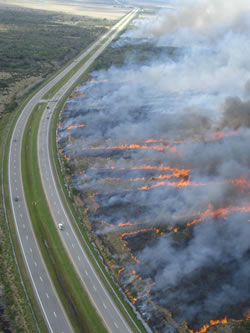Forests and Rangelands Success Story
Prescription for Cooperation
U.S. Fish and Wildlife Service, Merritt Island National Wildlife Refuge, Florida
National Fire Plan - Fuels Reduction
2010

Visibility remains clear along Florida State Highway 50 during a prescribed burn at St. Johns National Wildlife Refuge. Credit: Jeff Schardt, U.S. Fish and Wildlife Service.
How did firefighters at Merritt Island National Wildlife Refuge Complex in Florida successfully ignite and confine a prescribed burn to reduce risk along the major route between Orlando and the Space Coast? In October, they joined forces with the adjacent public land owner, with each agency burning on the same day to complete both burns.
The entire western boundary of the Complex’s 855-acre burn area along State Highway 50 borders the St. Johns River Water Management District. While keeping smoke away from the highway and holding the fire within designated boundaries was possible, past experience proved it would be challenging. The task would be difficult and time consuming, requiring a significant amount of staff and equipment.
So refuge firefighters formed a partnership with the water management district and Florida Division of Forestry to coordinate burn plans. The district allowed the refuge to run fire across its boundary, alleviating holding concerns; while refuge firefighters performed aerial ignition on the district’s land, in areas too difficult or dangerous to ignite by hand.
The cooperating agencies burned a total of 3100 acres west of St. Johns National Wildlife Refuge. By coordinating their efforts, they conducted the burns faster and more safely, using less equipment and fewer firefighters. More interagency burns are being planned for the future.